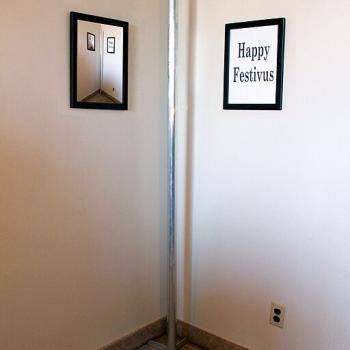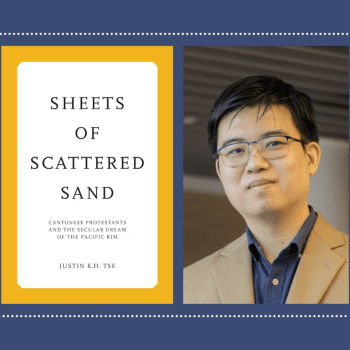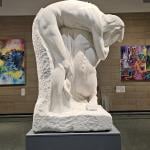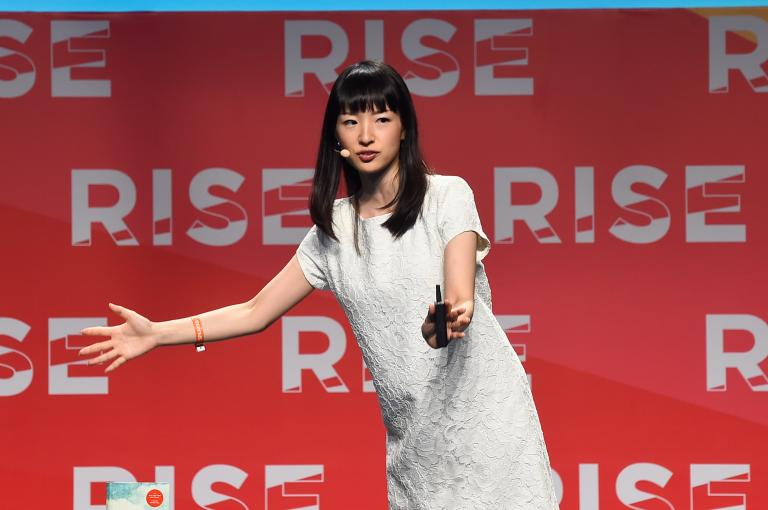
The families, homes, and clutter habits featured on the Netflix reality show Tidying Up with Marie Kondo are as diverse as America, but Japanese home organizing consultant Marie Kondo always begins her tidying projects in the same way: with a ritual in which she greets and thanks the house. This ritual is one of the most dramatic and poignant moments in the episode, and it follows a consistent script throughout the show. After Kondo explains her intent and offers instructions to her clients, bright piano chords suddenly cut the chatter. Kondo is then shown kneeling on the floor, silent, with her eyes closed and her head bowed, her fingers gently tracing the ground around her. The families are silent, with their heads bowed, too; the camera does a close-up of their hands clasped together, as in prayer. The episode is suspended in several peaceful moments of music and meditation until Kondo breaks the silence with a cheerful announcement: let’s start tidying!
For the television audience tuning in with the expectation of a straightforward home makeover show, the sacred moment when Kondo greets the home may be something of a surprise. However, the spiritual approach to tidying is one of the signature elements of Kondo’s “KonMari” method, which is profoundly influenced by her life-long practice of Shintoism. In her book, The Life-Changing Magic of Tidying Up, Kondo describes how she loves visiting her local shrine to pay her respects to deities and how she served as a Shinto shrine maiden for five years. Her home-greeting ritual originates in Shinto traditions. “I began this custom quite naturally based on the etiquette of worshipping at Shinto shrines,” she says. “I don’t remember exactly when I started doing it, but I believe I was inspired to do so because the tense expectancy in the air when a client opens the door resembles the atmosphere when one passes under a shrine gate and enters the sacred precincts.” On her television show, Kondo applies her tidying magic in a different cultural and religious context, but it’s clear that her American clients, like worshippers entering the gates of a Shinto shrine, experience a deep sense of anticipation. In one episode, the sound of Kondo arriving at her front door for the first time causes one woman to sigh and declare nervously, “Here’s the moment of truth!”
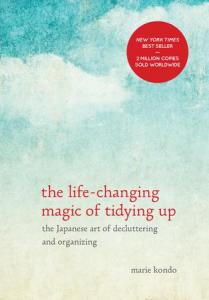 Indeed, facing the truth is an important part of Kondo’s mission. Kondo’s widespread popularity is due in part to the fact that she helps her clients and her viewers confront a powerful and painful reality: that excessive consumption brings chaos not only to our pocketbooks and our planet, but also our homes and our hearts. With gentle empathy, Kondo guides families in ambitious plans to reorganize their overstuffed closets, and at the same time reboot their lives and revitalize their relationships with one another. The objective of tidying is not simply to achieve more orderly homes, but to lead more orderly—and more joyful—lives. As she puts it, tidying is “life-changing.”
Indeed, facing the truth is an important part of Kondo’s mission. Kondo’s widespread popularity is due in part to the fact that she helps her clients and her viewers confront a powerful and painful reality: that excessive consumption brings chaos not only to our pocketbooks and our planet, but also our homes and our hearts. With gentle empathy, Kondo guides families in ambitious plans to reorganize their overstuffed closets, and at the same time reboot their lives and revitalize their relationships with one another. The objective of tidying is not simply to achieve more orderly homes, but to lead more orderly—and more joyful—lives. As she puts it, tidying is “life-changing.”
Tidying, in her view, is also magical, which raises a second point: that Kondo’s appeal owes in equal measure to the long-standing American fascination with Asian religions and, in particular, with Asian spiritual teachers who share their wisdom with the West. While the frenzy to declutter KonMari-style is very much a contemporary phenomenon, at the same time Kondo is the latest iteration of a century-old icon that is immediately recognizable to Americans: that of the “Oriental Monk,” or the Asian sage who offers life-changing guidance to Western pupils looking East for wisdom and spiritual awakening. Kondo’s success calls attention to the durability, ubiquity, and flexibility of this figure in American popular culture; after decades of seeing Oriental Monk narratives on film, television, and other media, American audiences now instinctively hunger for them. Ironically, while Kondo’s teachings encourage Americans to consume less, Americans can’t consume enough of her.
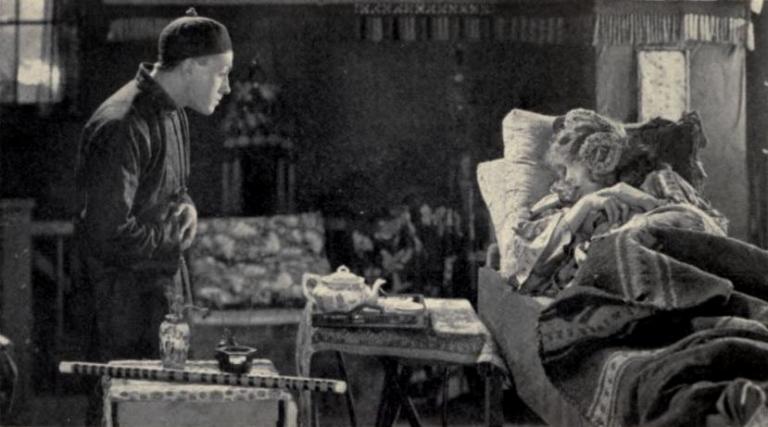
The Long History of the Oriental Monk in American Popular Culture
In her book Virtual Orientalism: Asian Religions and American Popular Culture, religious studies scholar Jane Iwamura defines the Oriental Monk as “the representative of an otherworldly (though perhaps not entirely alien) spirituality that draws from the ancient wellsprings of ‘Eastern’ civilization and culture.” The Oriental Monk, in both its real or fictional forms, is distinguished by a few key features: “his spiritual commitment, his calm demeanor, his Asian face, his manner of dress, and—most obviously—his peculiar gendered character.” Moreover, the Oriental Monk is the central figure in stories of East-meets-West spiritual encounter. Iwamura explains that, in this narrative, “Orientalist notions of Asian spiritual heritages converge with Western disillusion and desire,” and the standard plot centers on a close, transformative relationship between the Asian sage and his Western pupil:
“A lone monk figure—often with no visible family or community—takes under his wing a fatherless, often parentless, child (usually a boy). This child embodies a tension—although he signifies the dominant culture in racial terms, he has an ambivalent relationship with that culture. This allows him to make a break with the Western tradition that is radical enough to allow him to embrace his marginalized self. The Oriental Monk figure discerns this yearning for difference, develops it, and nurtures it. As a result of this relationship, a transmission takes place: Oriental wisdom and spiritual insight is passed from the Oriental Monk figure to the West through the bridge figure of the child. Ultimately, the Oriental Monk and his apprentice( s) represent future salvation of the dominant culture—they embody a revitalized hope of saving the West from capitalist greed, brute force, totalitarian rule, and spiritless technology.”
The Oriental Monk is a recognizable character to Americans, who have long encountered this icon and his mysterious and transformative Eastern wisdom through film, television, music, and print culture. His presence onscreen reaches back a full century, beginning with D. W. Griffith’s 1919 film, Broken Blossoms or the Yellow Man and the Girl. In this film, a noble and devout Buddhist man endeavors to spread a message of peace and enlightenment to the West. To do so, he journeys from China to London, where he rescues a poor English girl from her abusive father. In this film, Griffith helped to shift the public perception of Asian people, by changing the main character from the heathen “Chink” (the original terms used by Thomas Burke, author of the short story on which Broken Blossoms was based) to the noble Oriental Monk. In addition, the flipped narrative—of East saving West, rather than the other way around—was a groundbreaking one that reflected the religious turmoil of the period. “Broken Blossoms hints at a subtle but growing disillusionment with institutionalized Christianity and a budding fascination with alternative modes of moral and spiritual understanding,” Iwamura writes. Broken Blossoms thus offered a cautionary tale to the Christian West. “Eastern spirituality has been representationally idealized and operates civilly in its new Western home,” she explains. “In this way, Broken Blossoms lays the groundwork for the West’s further engagements and later spiritual identification with the East. The message will be transformed from one of threat and consequence to one of desire and hope: If the Christianized West is unable to care for its children, the noble Buddhist East will!”
Broken Blossoms was only the beginning. In subsequent decades, the figure of the wise and mysterious Oriental Monk would appear again and again, adapting deftly to changing geopolitical and cultural circumstances and capturing the fascination of American audiences in new ways, all while retaining its distinctive features. In the 1920s and 1930s, there was Charlie Chan, the perspicacious detective who solved cases while also dispensing wisdom through abstruse, ungrammatical aphorisms (“Smart fly keep out of gravy”; “Action speak louder than French”). In the 1950s, there was D. T. Suzuki, who helped introduce America to Zen Buddhism, most notably through his influence on celebrities such as the Beat poets. In the 1960s, there was Maharishi Mahesh, the Beatles’ personal guru. In the 1970s, there was Kwai Chang Caine in the television series Kung Fu, and today there is Deepak Chopra and the Dalai Lama.
The various incarnations of the Oriental Monk shed light on how Americans have defined themselves religiously in the context of a century of changing relations between Asia and America. Just as important, the icon of the Oriental Monk has shaped how Americans have engaged in Asian religions and sought to define and contain the threatening Asian Other. “Through the figure of the nonsexual, solitary Oriental Monk, Asian religiosity and spirituality are made palatable—psychologically, socially, and politically—for dominant culture consumption,” writes Iwamura. “Hence, the Monk as signifier serves as a way for Americans to manage Asian American religious communities by re-presenting Asian spiritual heritages in a specific way—that is, by reinforcing certain comforting assumptions and presenting the Other in a manner that is recognizable and acceptable.”

Tidying Up as Televised East-West Spiritual Encounter
On Tidying Up, Marie Kondo does not describe herself to her clients as a religious leader, but she nevertheless conveys a combination of Asian wisdom, tranquility, and spirituality that is characteristic of the Oriental Monks who came before her. Kondo’s otherworldliness is immediately apparent to viewers through her physical presence, which offers a striking visual contrast to the American families she is on a mission to help. Petite and spritely, Kondo flits nimbly through messy rooms, even as her clients stumble over the clutter in their own homes. She dresses in pristine white tops, wears a warm smile at all times, and speaks in a soft, gentle voice. The overall effect is to portray her as an ethereal, unearthly creature who, as her clients put it, has “a presence” and “an aura” about her.
This magical aura and mystical spiritual presence are highlighted during Kondo’s brief homilies on tidying. At certain points throughout each episode, the camera cuts away from footage of families sorting socks and transports viewers to a peaceful, pastel-hued home—a sort of temple of tranquility and tidiness. In this place, Kondo sits serenely on a couch and sermonizes on a wide range of matters—how to roll men’s neckties, how to cope with the death of a loved one—all while being filmed through a lens that blurs the background so that the focus is on her placid, smiling face.
Kondo’s distinctive tidying practices further underscore her Asian spirituality and fit her into the Oriental Monk mold. There is, first of all, the greeting of the house, the ritual that commences every tidying endeavor. On the television show, it’s clear that greeting and thanking the house is a new practice for the American clients (“I’ve obviously never done that before!” said one dad) but they all participate, if a little uncertainly and nervously at first. Kondo uses the ritual as a way to acquaint herself with the house and as an opportunity for her clients to clarify their intentions, which will fortify them for the tidying journey that lies ahead. If her clients still feel tense or daunted by the work they have to do, she encourages them to purify the space and “change the air” through practices that resemble those pursued in a traditional religious space. “Create a sound that has a great vibration,” she says. “Light a candle. Spray an aromatic room spray. Lighting some incense is also an option—by creating smoke, it’ll purify the room.”
Then comes sorting and organizing. Here, too, Kondo centers the work on ritual and requires that her clients reflect on whether every individual object “sparks joy.” In order for her clients to fully evaluate their relationship to each item, Kondo advises them to hold each object in hand and speak words of gratitude to it. One teenage boy, for example, affectionately picks up an item of clothing and uses all of his senses to heighten his sense of appreciation. “You’ve done so much good for me!” he says to one garment. “I thank you for that.” He presses the item of clothing to his chest in a warm embrace and buries his face in the cloth to smell and kiss it. “How have I not worn you before? You bring me so much joy!”
Kondo emphasizes that her clients should honor their belongings by handling them with love and appreciation. She admonishes her clients if they rudely toss objects onto a pile, rather than setting them down gently and respectfully. She also teaches her clients to store objects properly—usually vertically, which respects their energy. “When you treat your belongings well, they will always respond in kind,” she explains in her book. “For this reason, I take time to ask myself occasionally whether the storage space I’ve set aside for them will make them happy. Storage, after all, is the sacred act of choosing a home for my belongings.” On her show, she doesn’t even sort items until she feels they are ready to be sorted. For example, she taps on books before she organizes them, explaining that she wants “to wake them up first,” as “books that have been stored in boxes a long time are sleeping.”
Kondo encourages her clients to recognize the sacred reciprocal bond that connects humans with their homes and the items in it. “The destiny that led us to each one of our possessions is just as precious and sacred as the destiny that connected us with the people in our lives,” she writes. “There is a reason why each one of your belongings came to you…Everything you own wants to be of use to you.” In Kondo’s view, household items care for humans, just as humans care for household items. On the television show, this idea serves as a source of comfort and encouragement for a recently widowed woman who is overwhelmed by the task of organizing her entire house by herself. “You’re not alone,” Kondo assures her. “The house itself and all your belongings are there to support you and are with you.”
This woman does eventually succeed in organizing her home, and at the end of the episode, she is effusive with gratitude and praise for Kondo. “Thank you to my mentor!” she exclaims with clasped hands and a bow. This moment—when clients reflect on their journey, give thanks to Kondo, and offer testimony to how her teachings have transformed their lives and deepened their understanding of home organization, of themselves, and of life—is the one that hews to the familiar Oriental Monk narrative most closely. Like a gently tapped book, their spirits have been woken up, thanks to their Eastern spiritual teacher and her wise ways.
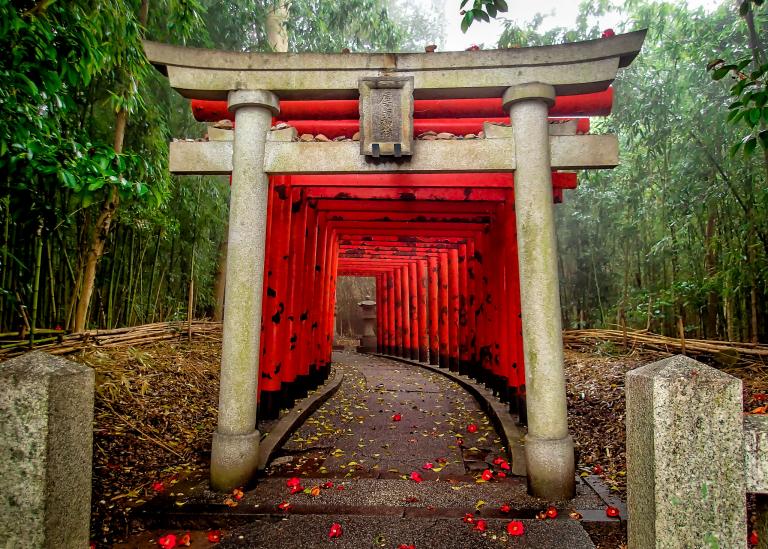
An Asian Sage for the 21st Century
As with any makeover reality show, Tidying Up leaves its audience with a question: how long will the transformation will last? Will the families continue to thank their things and say hello to their homes? Will they maintain their tidy columns of tri-folded tee-shirts and their neat rows of rolled-up neckties? Anybody who has struggled with disarray, domestic or otherwise, knows that the task of sustaining order once it has been established is the true challenge. But even if the families’ homes revert to chaos and clutter after Kondo and her camera crews have left, the real longterm impact of the show on our culture will likely be more impactful: in particular, an indelible set of ideas about Japanese spirituality, and a renewed (if revised) version of the Oriental Monk in the American imagination.
Whether or not she intentionally aims to capitalize on the figure of the Oriental Monk, Kondo clearly benefits from the path forged by the Asian sages who enthralled Western audiences for generations before her. Like her Oriental monk predecessors, she is celebrated for her serene spirituality and her insightful ability to enlighten her Western pupils. Her appeal is centered on her role in facilitating personal transformation. And, somewhat contradictorily, her appeal also depends on her maintenance of the status quo—namely, her reinforcement of an old and familiar set of ideas about the mystery and wisdom of the East that Americans have been primed to consume for over a century.
It’s worth acknowledging that Kondo departs from the traditional Oriental Monk figure in several ways. Most obviously, she’s a woman. Moreover, she’s not overtly religious; though Shinto beliefs and practices clearly animate her work, she doesn’t describe herself as a religious or spiritual leader, but as a tidying expert and home organization consultant. But her departure from the style of past Oriental Monks reveals the power of this icon, which endures through its ability to adapt to different cultural, geopolitical, economic, and social conditions. “In a consumer-oriented society, we have seen how Virtual Orientalism accommodates the demand for novelty by introducing new versions of the [Oriental Monk] icon,” observes Iwamura. “…This substitutability is possible because a mass audience is less concerned with the distinctiveness of the figure or the religious tradition he represents than with the desires the iconic figure meets and the operations he performs.”
Indeed, Kondo’s popularity illuminates the desires and discontent of Americans living in this particular historical moment. Her effort to rein in acquisitiveness appeals to Americans who are increasingly horrified by the excess of consumer society and its impact on their homes, their environment, their bank accounts, and their souls. Her spiritual (but not overtly religious) approach appeals to Americans who have become disillusioned by organized religion but who retain a deep interest in spirituality despite being categorized as religious “nones.” Finally, the fact that Kondo comes from Japan—a country that Americans associate with “great spiritual richness,” Iwamura points out—appeals to Americans who are anxious about their nation’s diminished status in the world and are looking for a more contained and less threatening Asian alternative to China. (It is perhaps no wonder that another cultural phenomenon of recent months, the blockbuster film Crazy Rich Asians, presents ethnic Chinese people in a decidedly negative light—as glamorously rich, yes, but also crazy. In contrast, Kondo, as the peaceful and wise Oriental Monk figure, is able to rise above the crass allure of capitalist mass consumption and also hails from the nation that is the lesser geopolitical threat in the 21st century. )
As this last point makes clear, Marie Kondo is significant not simply because she might help us reorganize our homes and reshape our spiritual practices and imaginations. She matters because she is part of a longer history of Oriental Monks in American popular culture who have provided many Americans with their first encounter with Asian spirituality. Moreover, it is through the Oriental Monk icon that longstanding Orientalist ideas and unequal relations of power have been reinforced. As Iwamura observes, “the figure of the Oriental Monk in its variegated forms serves as a measure of U.S. geopolitical relations with Asia; these forces are mapped onto the icon through aspects of race, class, national origin, and sexuality…the monk as spiritual guide acts as a mirror as well as a screen for a wide range of ideological interests related to the posture of the United States in the global political economy.” Ultimately, the impact of Oriental Monks like Marie Kondo are not simply felt in the home and the heart, but in the broader culture and the realm of geopolitics.
As it turns out, when one opens up the closets and takes a closer look, tidying up is indeed messy business.





